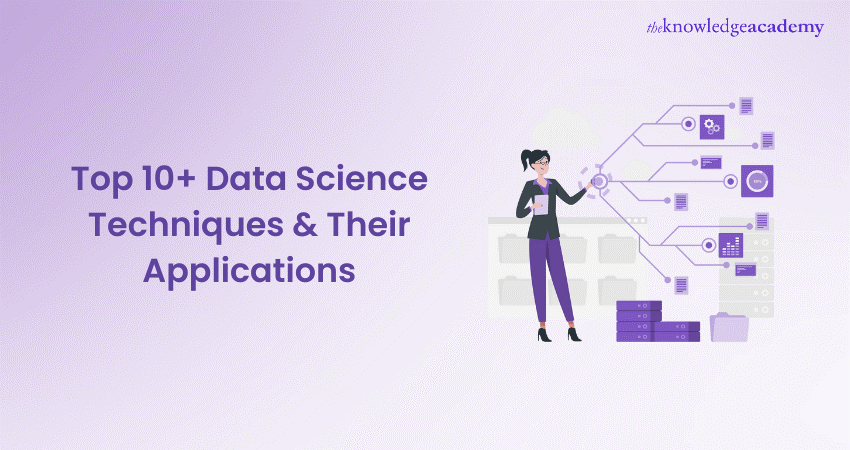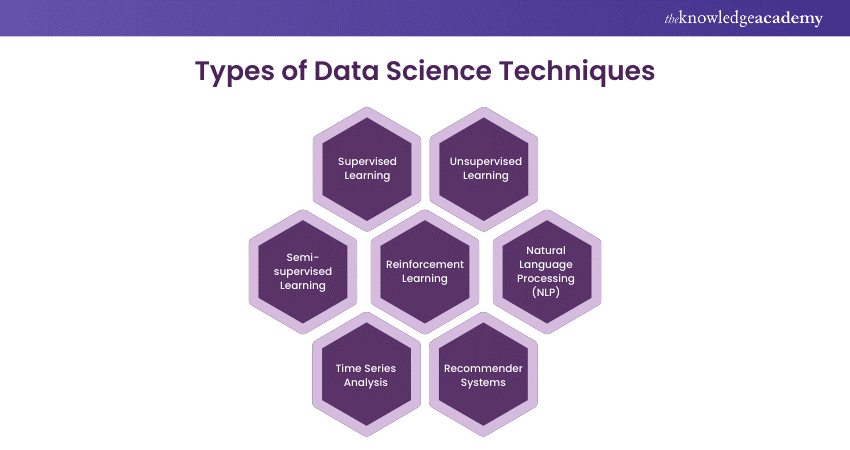We may not have the course you’re looking for. If you enquire or give us a call on 01344 203999 and speak to our training experts, we may still be able to help with your training requirements.
Training Outcomes Within Your Budget!
We ensure quality, budget-alignment, and timely delivery by our expert instructors.

In today’s technology-driven world, Data Science Techniques have emerged as the backbone of innovation and problem-solving. By familiarising oneself with these revolutionising Techniques, industries can pave a bright future in decision-making. They can also step ahead and make significant advancements.
According to LinkedIn, there are more than 5 million job openings in the field of Data Science worldwide. These statistics clearly indicate that organisations are eagerly looking for specialists with a deep knowledge of Data Science Techniques.
Therefore, if you want to build a bright future in this field, it’s the right time to understand these strategies. Don’t know where to start? Worry no more. Read this blog to learn about top Data Science Techniques used in 2024. Also, explore their significance and real-world applications.
Table of Contents
1) Types of Data Science Techniques
a) Supervised Learning
b) Unsupervised Learning
c) Semi-supervised Learning
d) Reinforcement Learning
e) Natural Language Processing (NLP)
f) Time Series Analysis
g) Recommender Systems
h) Clustering Techniques
i) Dimensionality Reduction
j) Regression Analysis
2) Real-world applications of Data Science Techniques
3.) Conclusion
Types of Data Science Techniques
Data Science encompasses a diverse set of Techniques and methodologies aimed at extracting valuable insights and knowledge from data. These methods can be broadly classified into various categories, each serving distinct purposes in the Data Analysis process. Here are some of the key Types of Data Science Techniques:

1) Supervised Learning
In Supervised Learning, algorithms are trained on labelled data, where each data point is associated with a known output. The goal is to learn a mapping between inputs and outputs to predict new, unseen data accurately. Common applications include image recognition, sentiment analysis, and spam filtering.
2) Unsupervised Learning
Unsupervised Learning deals with unlabelled data, where the algorithm identifies patterns and structures without explicit guidance. Clustering is a common application of this learning, where data points are grouped based on similarities.
3) Semi-supervised Learning
This type of Learning combines labelled and unlabelled data to improve model performance. It is useful when obtaining large amounts of labelled data is challenging or costly.
4) Reinforcement Learning
Reinforcement Learning involves training agents to make decisions in an environment to achieve specific goals. The agent receives feedback as rewards or penalties, guiding its behaviour towards optimal actions.
5) Natural Language Processing (NLP)
NLP focuses on enabling machines to understand, interpret, and generate human language. Sentiment analysis, language translation, and chatbots are some applications of NLP.
6) Time Series Analysis
Time Series Analysis deals with data points ordered by time, enabling predictions for future events based on historical patterns. It is commonly used in financial forecasting and stock market analysis.
7) Recommender Systems
Recommender Systems provide personalised recommendations to users based on their preferences and behaviour. This enhances user experiences on various online platforms.
8) Clustering Techniques
Clustering Techniques group similar data points together based on certain criteria. This allows customer segmentation and anomaly detection.
9) Dimensionality Reduction
Dimensionality Reduction Techniques aim to reduce the number of features in a dataset while retaining the most important information. This helps in faster processing and visualisation of data.
10) Regression Analysis
Regression Analysis is used to model the relationship between variables and make predictions based on their association. It is commonly employed in forecasting sales, pricing models, and trend analysis.
11) Decision Trees and Random Forests
Decision Trees are used for classification and regression tasks. On the other hand, Random Forests combine multiple decision trees to improve prediction accuracy.
12) Neural Networks and Deep Learning
Neural Networks are a class of algorithms inspired by the human brain. At the same time, Deep Learning involves training deep neural networks to learn from complex data representations.
13) Association Rule Mining
Association Rule Mining discovers interesting relationships between variables in large datasets commonly used in market basket analysis and recommendation engines.
14) Text Mining
Text Mining Techniques extract valuable information and patterns from unstructured textual data. As a result, it enables sentiment analysis, topic modelling, and information retrieval.
Explore the transformative potential of blockchain technology with our comprehensive Data Science and Blockchain Training - join now!
Real-world applications of Data Science Techniques
Data Science Techniques have revolutionised the way businesses and industries operate, providing invaluable insights and solutions to complex challenges. Let's explore some of the real-world applications of these methods across various domains:
1) Healthcare
Data Science has profoundly impacted healthcare, transforming patient care and medical research. Techniques such as Machine Learning and NLP are used to analyse medical records and identify patterns that can aid in early disease detection. Medical imaging analysis powered by deep learning algorithms has significantly improved diagnostic accuracy. Furthermore, these methods are employed to predict disease outbreaks, optimise hospital resource allocation, and personalise treatment plans based on individual patient data.
2) Finance
These algorithms play a crucial role in risk assessment, fraud detection, and algorithmic trading in the finance industry. Machine Learning models analyse vast amounts of financial data to identify potentially fraudulent activities and unusual transaction patterns. Moreover, algorithmic trading strategies leverage Data Science Techniques to make high-frequency trades based on real-time market data, improving trading efficiency and profitability.
3) E-commerce and Retail
Data Science Techniques are extensively used in e-commerce and retail to enhance customer experiences and drive sales. Recommender Systems leverage collaborative filtering and user behaviour data to provide personalised product recommendations. This increases customer engagement and retention.
Further, sentiment analysis of customer reviews helps businesses understand customer feedback and sentiments towards products, enabling them to improve accordingly.
4) Marketing and Advertising
Data Science Techniques have revolutionised marketing and advertising strategies, enabling businesses to target their audiences more effectively. Customer Segmentation Techniques group individuals with similar characteristics. This allows marketers to tailor marketing campaigns to specific target groups.
Moreover, A/B Testing and Multivariate Testing enable marketers to optimise website layouts and content, enhancing user experiences and maximising conversions.
5) Transportation and logistics
These methods are instrumental in optimising transportation and logistics operations. Route optimisation algorithms help logistics companies plan efficient delivery routes. As a result, they reduce transportation costs and delivery times. Additionally, Predictive Maintenance Techniques leverage sensor data to predict equipment failures in advance, minimising downtime and ensuring smooth operations.
6) Social media and sentiment analysis
Social media platforms generate huge amounts of data, and Data Science Techniques are employed to analyse this data for various purposes. Sentiment analysis helps businesses gauge public opinions and reactions to products or events. As a result, businesses are able to respond effectively to customer feedback. Social media data also provides valuable insights into customer preferences and trends, helping businesses stay relevant and competitive.
7) Internet of Things (IoT)
With the proliferation of IoT devices, Data Science Techniques are used to analyse data streams from various sensors and devices. These methods enable real-time monitoring and decision-making in smart cities, smart homes, and industrial IoT applications. Data-driven insights from IoT data enhance efficiency, optimise resource utilisation, and improve overall system performance.
Level up your data skills with our comprehensive Data Science Courses – register now!
8) Education
Data Science Techniques are increasingly being used in the education sector to improve learning experiences and student outcomes. Learning Analytics analyse student performance data to identify learning patterns and provide personalised feedback to students and educators. Predictive models help identify students at risk of academic challenges, enabling timely interventions to support their progress.
9) Gaming and entertainment
Data Science Techniques are utilised in the gaming industry to improve player experiences and enhance game design. Game developers analyse player behaviour data to understand player preferences and adjust game mechanics accordingly. Personalisation algorithms tailor in-game content and rewards to individual players, boosting engagement and retention.
Conclusion
Data Science Techniques have emerged as a powerful force driving innovation and progress across diverse sectors worldwide. As the world moves forward, the continued evolution of Data Science promises even greater advancements. This will help in shaping a data-centric future where data-driven insights will continue to empower us to overcome challenges.
Level up your Data Science skills and excel in data manipulation and analysis - Join our Pandas For Data Analysis Training now!
Frequently Asked Questions

Data Science in Artificial Intelligence (AI) is the application of Data Science Techniques and tools to create Artificial Intelligence systems that can learn from data and perform tasks that usually require human intelligence. AI Data Science involves data collection, preparation, analysis, modelling, and deployment.

The four branches of Data Science are as follows:
a) Data Engineering
b) Data Analysis
c) Data Visualisation
d) Machine Learning

The Knowledge Academy takes global learning to new heights, offering over 30,000 online courses across 490+ locations in 220 countries. This expansive reach ensures accessibility and convenience for learners worldwide.
Alongside our diverse Online Course Catalogue, encompassing 17 major categories, we go the extra mile by providing a plethora of free educational Online Resources like News updates, Blogs, videos, webinars, and interview questions. Tailoring learning experiences further, professionals can maximise value with customisable Course Bundles of TKA.

The Knowledge Academy’s Knowledge Pass, a prepaid voucher, adds another layer of flexibility, allowing course bookings over a 12-month period. Join us on a journey where education knows no bounds.

The Knowledge Academy offers various Data Science Course, including Python Data Science, Data Mining and Text Mining Training. These courses cater to different skill levels, providing comprehensive insights into Data Science.
Our Data Analytics & AI Blogs blogs covers a range of topics related to ISO and Compliance, offering valuable resources, best practices, and industry insights. Whether you are a beginner or looking to advance your Compliance skills, The Knowledge Academy's diverse courses and informative blogs have you covered.
Upcoming Data, Analytics & AI Resources Batches & Dates
Date
 Python Data Science Course
Python Data Science Course
Mon 24th Mar 2025
Mon 26th May 2025
Mon 28th Jul 2025
Mon 20th Oct 2025
Mon 1st Dec 2025







 Top Rated Course
Top Rated Course



 If you wish to make any changes to your course, please
If you wish to make any changes to your course, please


